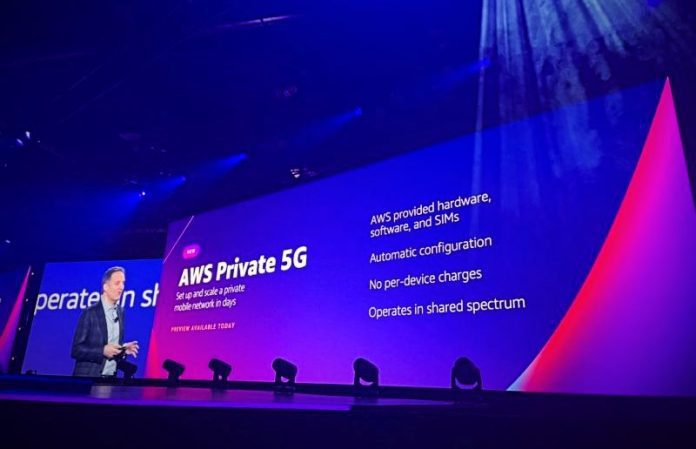So AWS responded about some of the finer details in its new private 5G offer, announced yesterday. What have we learned? Not much, at least in terms of the identity of the networking partners it is using for the project. But there was some useful clarification about its direction of travel, and passing reassurance to public network operators, with which it is hammering out separate co-creation style deals at both the network edge and the ‘far’ edge.
Significantly, George Elissaios, general manager for EC2, the AWS unit in charge of elastic compute (EC2), says AWS is working with public mobile network operators (CSPs) to make the new AWS Private 5G service compatible with their licensed spectrum in localised enclaves, in theory in remote locales where public usage is minimal anyway and they see fit to hive-off to important enterprise customers.
The service is designed to work with any spectrum, he explains; it is “spectrum agnostic”, he says. Ultimately, enterprises can ‘bring their own’, whether via dedicated vertical spectrum licences in their regions, in shared allocations, or in conjunction with public operators. He responds: “AWS Private 5G… can work with licensed, unlicensed and even support ‘bring-your-own’ spectrum, for customers that have their own.”
Elissaios continues: “AWS 5G operates in the CBRS spectrum by default, and AWS is collaborating with CSPs to make private 5G available in partners’ licensed spectrum to provide customers dedicated network connectivity.” What about compatibility with hybrid public-private (PNI-NPN) setups, where resources are shared between? Is there an option to choose the public network for the core component? “No,” comes the response.
Any kind of remotely-located 5G core network function will be hosted by AWS, in AWS ‘points of presence’; the rest will run on its on-site Outposts edge functions. He clarifies: “AWS Private 5G is designed to support running the core in the region, [on] AWS Local Zones, or on premises with AWS Outposts and Outpost servers.”
Okay, so does the AWS Private 5G offer represent competition to traditional telco carriers? “No,” says Elissaios. “We are partnering with carriers to meet customer needs, like access to licensed spectrum, demanding radio frequency planning in those bands, [and so on].” But how should they square this move, to take charge of private 5G provision, with their collaborations with AWS at the MEC edge?
Elissaios responds: “As complementary. Across the board we are partnering with CSPs to offer a complete solution for our customers across key building components: compute, storage, network, spectrum. For example, AWS Wavelength embeds AWS compute and storage services within telco 5G networks, providing mobile edge computing infrastructure for developing, deploying, and scaling ultra-low-latency applications for a wide number of end users.”
To an extent, it might be argued, his answer appears to carve-up ownership of the edge, between easy on-site installations from AWS and more general-purpose carrier-provided MEC functions, also powered by AWS. “AWS Wavelength makes use of carrier public networks and spectrum they license themselves. We embed compute/storage into CSPs offerings of private networks,” he goes on.
“With AWS Private 5G we offer a managed service that makes it easy for enterprises to deploy, operate, and scale their own private cellular networks.” The balance of power for telcos with this ‘co-opetition’ (eugh) trend, about cooperating with competitors, is writ-large in these statements. The AWS mission to provide elastic-scale compute and storage at every point in the edge-cloud continuum will carry the private 5G story with it, it suggests.
AWS will work with anyone and everyone to fill the gaps, between centralised cloud and distributed edge. But the traffic is one-way, and it is up to the private 5G community to define their own roles and make their own fortunes – and up to carriers to make their licensed spectrum count, as possible, and their go-to-market strategies compete and cooperate.
What of its other partners? Because a noisy gang of new-age telecoms providers, on a coltish breed of open-networking thoroughbreds, given a right to roam by spectrum liberalisation and industrial change, is riding into town. Speculation about their identities is not going to come to anything, yet, says AWS. Elissaios is only prepared to confirm the networking components in its private 5G offer are from third parties.
He comments: “The RAN and core functions are provided by technology partners. The rest has been developed by AWS. AWS is making the servers.” Tellingly, he confirms as well that AWS will host products from multiple partners for each 5G component. “In the fullness of time AWS Private 5G will support various RAN and core partners.”
Does the customer know the companies they are choosing for each of these – or are they white-labelled, or hidden from view, branded completely as AWS Private 5G? “We will start with a basic service offering labelled AWS Private 5G. As more vendors onboard, we will have a way to show different components that customers can choose as part of AWS Private 5G service.”
There is a lot to ‘unpack’, and lots to be revealed. AWS presented the news as a ‘preview’ only; time will tell how its proposition is welcomed by enterprises, and how it impacts the market.
Related, a recent study by analyst house Omdia says hyperscalers, with only varied and newly acquired in-house 5G knowledge, are outpacing telcos, with 40 years in the game, at private 5G. It named Microsoft as the ‘top innovator’, ahead of AT&T and Deutsche Telekom. There is no mention of AWS in the press note about the study. Interestingly, the same survey says three quarters of enterprises want hybrid networks, tapping into public infrastructure besides.
Meanwhile, analyst firm Dell’Oro Group issued a good blog last week that tots-up total private LTE / 5G installations by key network vendors and says the tailwinds are fair, albeit somewhat blustery, and that the course is true, albeit hard-going. “While there are already thousands of commercial private networks, it would be a stretch to suggest the commercial private 5G RAN market has surprised on the upside from a revenue perspective,” it writes.
Stefan Pongratz, vice president at the firm, quotes figures from the traditional RAN vendors: Huawei has around 10,000 enterprise 5G projects, globally, he says, including “thousands of trials” on various 5G private use cases; Ericsson is involved in hundreds of private wireless customer engagements; Nokia claims over 380 private wireless customers (and around 1,000 networks); ZTE has more than “500 cooperative partners” in 15 industries.
He also includes a network-count by Federated Wireless, a key SAS provider in the liberated CBRS band in the US (and on the AWS books), which claims “hundreds of… private wireless trials” in multiple vertical domains. The total addressable market (TAM) for private LTE/5G is “large, approaching $10–$20 billion”, reckons Dell’Oro Group. Total revenues for private 5G, at least, will surpass $1 billion by 2025, even if they are outrun short-term by LTE revenues.
Enterprise IoT Insights and RCR Wireless are holding a free webinar on Thursday December 9 with Google Cloud on: The Role of Hyperscalers in 5G and Edge. The session – at 8am PT / 11am ET / 4pm GMT / 5PM CET – also features panellists from AT&T and Telecom Argentina. To attend, sign up here, or click on the image below.


